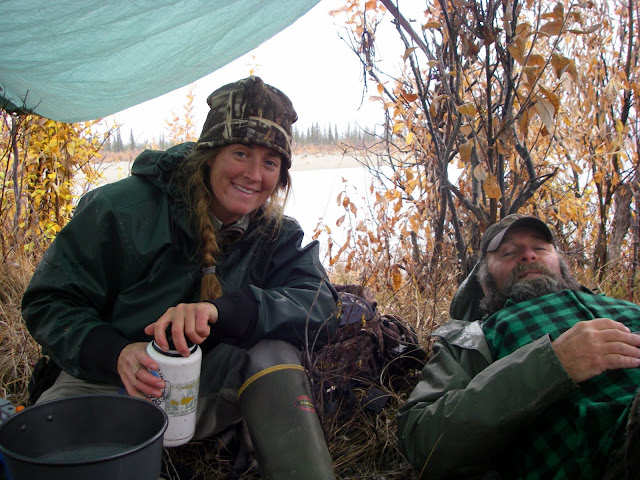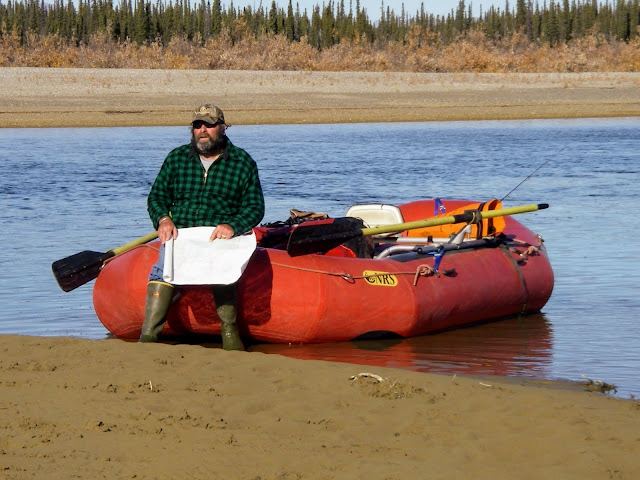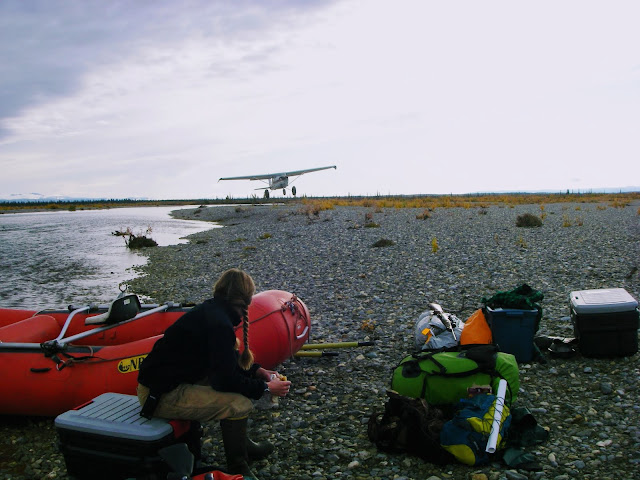It's been said that airplanes are used in Alaska in much the same way cars and trucks are used in the lower 48. One source says that one out of 60 people own an airplane. Many plane owners own more than one. One out of every 61 people is a pilot though not all pilots own their own airplanes. This is the greatest number of pilots in the US and the highest number in the world. In big cities like Anchorage, fewer people are pilots than in small communities where one out of every five people could be a pilot. Alaska has only 3 or 4 major highways. Even the state capital, Juneau, has no roads in or out and is accessible only by water or air.
Alaska is huge with great distances and impassable terrain between cities and villages. Airplanes provide quick travel. Despite the fact that much of Alaska is remote, Alaskans seem to crave being MORE remote. For this reason, many Alaskans routinely fly to cabins in the bush, to go hunting, fishing, clamming, berry picking, visiting or just to sight-see.Flying in small airplanes takes a bit of getting used to. For me, what I see from above, overcomes any anxiety I might have. When our daughter, Carlisle, asks if I want to go flying, I always say, "YES".
 |
| when floating rivers, gravel bars become local runways |
 |
| float planes make mountain lakes accessible |
 |
| one of the odder planes we've flown in, a 1943 Grumman Widgeon |
being dropped on the Squirrel River
This is a typical camp site. We tend to stay in one place for just one night unless the the hunting or weather dictates a longer stay. There's a burning desire to know what lies around the next bend of the river.
Our tent sits in the brush along the Emiliuk River, with our blue raft on the bar.
gawking as we float by
Animals feeding or strolling the river's edge are seldom disturbed by our raft floating quietly by. We often see moose and caribou, sometimes bear and occasionally musk ox, which are a sight to behold. What an unusual animal!
Bucky and I are so fortunate to have our daughter Carlisle along on these adventures. We would suffer without her expertise and her great strength is an added bonus.
dragging the bottom is never fun, but when it's due to a boat being heavy with meat, it's not a bad thing
this fellow wasn't shy about helping himself to left overs
Any hunter knows the ups and downs that accompany this activity. The sun doesn't always shine, the animals aren't always where they're expected to be, but nature never disappoints.
a western arctic sunset, in September, darkness has returned
no caribou! then we'll eat ptarmigan
on the banks of the Anisak River.....I called it the zebra rock
natural ice bowl, no need for refrigeration in the arctic
yes, it's cold
putting on a happy face despite the cold rain
A tarp provides some quick shelter from midday rain without having to set up camp. I remember that warm soup tasted darn good.
caribou racks left on the tundra
the time a grizzly came close to camp. One of my all time favorite photos.
no animals, we'll eat Grayling
wonder where we are?
I originally titled this post "flying" with the intent of showing through my photos the importance of airplanes in Alaska. Feelings and emotions are projected with photography. I've tried to capture the feelings and personal emotions that accompany this type of travel. In our busy lives, there are very few times when the outside world isn't intrusive. It's an interesting emotion when watching the airplane that placed you on unfamiliar ground, lift off and fly away, eventually becoming a speck and then erased from view. It is equally emotional to hear a plane's engine in the distance long before seeing it, hoping that it's your pick-up and that it will soon circle, land and return you to what is comfortable and familiar.
the tent remains up until it is confirmed we can make it out in one flight or in case of a weather delay
Several times, we have taken small planes to see bears in Katmai National Park and Lake Clark National Park. We also flew to view bears on Kodiak Island. Unfortunately, I have no pictures to show of the Kodiak brown bear. Bucky and I traveled from Kodiak City to South Frazer Lake in what could be considered the limo of float planes, a DeHavilland Beaver. I had secured, through a lottery bid, a three day stay in a NPS cabin near the Dog Salmon River during the weeks of prime bear viewing. Here the bears are easily seen feeding on Sockeye. It was quite a score! The day we were to fly out, Kodiak was socked in as it so often is. The ceiling was too low to fly and rain fell steadily often seeming to come at us sideways.
Our flight service had suggested that if we questioned the adequacy of our rain suits, that we stand in the shower for five minutes wearing them and see if we remained dry!
At our scheduled time of departure, we were notified that storms were too severe to fly us to our cabin. We impatiently waited all day to receive a late afternoon call saying that the weather had lifted enough to fly. We high tailed it to the float dock. Our gear, including a Zodiac and motor, was quickly loaded and our pilot hastily became airborne. It was done in such a rush that I have no memory of our pilot's name or really what he looked like. It wasn't long into our hour long trip that turbulence hit. I knew I could probably fight air sickness, but wasn't sure about Bucky, who sat up front with our pilot. We bounced along, at times so severely that I checked behind me to see if the cargo net was still secure. I certainly didn't want to get bonked by the outboard motor. I heard through my headset, that Bucky was asking the pilot for more air. All vents were pushed wide open and a refreshing rainy mist hit my face. This gave me hope that both of us would not be sick. Between long bouts of rising and falling air, there were minutes of calm air providing hope that the worse was over. During these times, I was able to push aside the nausea that was steadily building. Finally, upon the conclusion of a prolonged stretch of rough air, Bucky and I simultaneously reached for our air sick bags.
The float plane glided to a stop and idled to the beach. Our camping gear, boat, motor, coolers and fishing gear were placed on the beach. Bucky and I walked past it all having no energy to carry it to the cabin.We knew with bears around it was unwise to leave our belonging including food on the beach, but were too sick to deal with it. Instead, we hurried over the boardwalk leading to the cabin. Once inside, we flopped down on the bunk beds lining the cabin wall, thinking we would never feel well again. Surprisingly, within a few hours we had recovered enough to be able to retrieve our untouched gear. We inflated the Zodiac, attached the outboard motor and headed across Frazer Lake. In moments. we were sitting mere yards from a sow wrestling with her cubs. Other bears fed on fish in the river while some strolled through the surrounding tall grass, occasionally rising onto their rear legs to get a better view. I find this posture to be both amazing and terrifying as bear and human eyes meet! Watching these animals was incredible. Unfortunately, I had no camera to record it. At some point during our turbulent flight, my camera had flown out of the cargo area, I'm thinking that it could have been during a particular series of violent bumps, when despite my overly tight seat belt, my head touched the plane's ceiling.
The following day we motored again across the lake to the Dog Salmon River. I was curious if the playful cubs of the previous day would be back. We landed the Zodiac and I took a seat on the grassy knoll next to a pilot who had flown a young family in. Our conversation, as conversations often do, turned to discussing the weather. I spoke of the previous day's storms and he commented that his company had quit flying early in the day, much before we took off. I included some details about our flight and the fact that my camera had slipped out of the cargo compartment. It was then that he said he had heard over the radio about our rough ride and that a camera had been "left" on a plane. I then asked if he could talk to our air service and have my camera put on the plane scheduled to pick us up. Luckily, that did happen, but I felt cheated by not having it at this special time. I did have it for the next leg of our trip which took us from Kodiak to Katmai National Park and Brooks Falls, also famous for bears. Our flight over Shelikoff Strait was smooth as silk.
bears don't like to share their fish
looking for fish
this wolf peered through the grass toward the river also in search of fish
People from around the world travel to Katmai National Park during July and August, arriving by float plane on turquoise Naknek Lake. There is no land runway or access by land.
Bucky retreating
When we weren't looking at bears, we tried our luck competing with them for fish.
We spent a few nights sleeping on the floor of Roy Fure's cabin on Naknek Lake, owned by the park service. I can't believe there's a sweeter place on earth.
In Lake Clark National Park, we watched coastal bears digging clams and eating grasses. a much more delicate approach to a meal than that of the Brooks bears. Here we made a beach landing on Chinitna Bay and our pilot became our bear guide.
not the best weather, our pilot in brown pants and airplane in background
young bears love to wrestle
Airplanes and bears are connected in many ways including the fact that bears sometimes eat airplanes as they love gnawing on anything smelling of fuel, food, in particular fish or sometimes just for fun.
this is not our airplane and not my photo
to be continued.....






























































